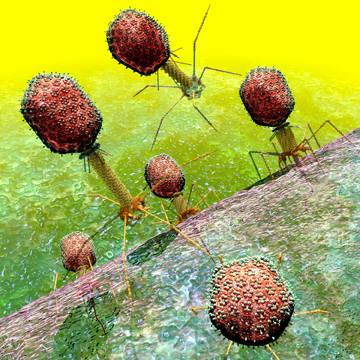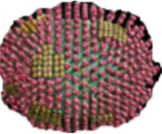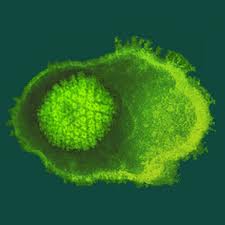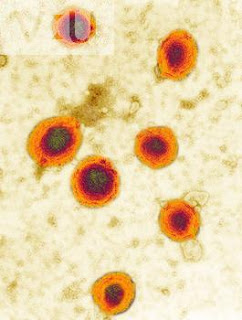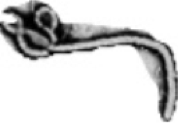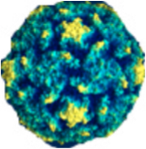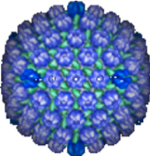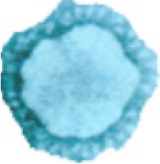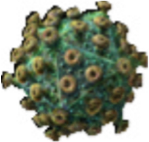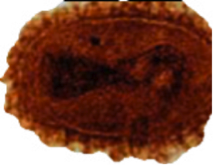Non-Living Infectious Agents
Criteria for Life
Scientists generally agree that there are four requisite characteristics of living organisms.
- They have one or more cells with DNA.
- They are capable of reproducing, growing, and developing.
- They are capable of capturing & using energy & raw materials.
- They are able to sense & respond to the environment.
- They are capable of evolving over generations.
All of the organisms belonging to the five kingdoms of living things in the previous sections of this module have all five of these characteristics. However, there are two types of infectious agents that do no meet these criteria:
- viruses and
- prions
Viruses
Viruses are assembles of organic molecules that consist of some short strands of RNA or DNA encapsulated within a protein shell. They are often referred to as if they were living organisms, but they don't meet the criteria listed above for living things. In a sense, they perhaps represent a primitive assembly of organic molecules that resemble living cells, yet they do not have the complexity and the the characteristics needed to be truly living organisms that are capable of reproducing independently, responding to the environment, and capturing energy on their own. Instead, all of the viruses are all parasitic, because they all need a living host cell in order to replicate. Once they bind to living cells and get taken up, they can use a host's cellular energy and machinery (e.g., ribosomes) to replicate its genetic material and its proteins, and these can self-assemble into new virus particles. These can lie dormant, or they can cause the host cell to rupture, releasing the progeny virus particle, which can go on to infect other host cells. Viruses can infect all kinds of living cells, including bacteria, and almost all viruses are pathogenic . When viruses infect a host cell, they can cause disease through several possible mechanisms:
. When viruses infect a host cell, they can cause disease through several possible mechanisms:
- Weakening the cell membrane or lysosomal membranes, leading to lysis of the cell
- Triggering the body's immune system to attack and destroy virus-infected cells
- Provoking such a strong response from the body's immune system that itself damages or kills the host. For example, Hanta virus infection provokes a vigorous inflammatory response that results in large amounts of edema fluid in the lungs which interferes with oxygenation uptake.
- Weakening immune function. For example, HIV specifically binds to the CD4 protein on helper T-cells which help coordinate the host's immune system by activating B-cells and cytotoxic T-cells. As a result, the body cannot make antibodies, and the HIV cannot be eliminated. The virus is therefore free to multiple and infect other helper T-cells. Over time there is a substantial loss of helper T-cells and a greatly diminished ability to fight any pathogens.
- Synthesizing viral proteins that interfere with host cell function. For example, when certain strains of human papilloma virus (HPV) infect a host cell, they synthesis two proteins (E6 and E7) that promote cancer formation by blocked the tumor suppressors Rb and p53.
DNA Viruses
In the general process of infection and replication by a DNA virus (e.g., Herpes simplex, type 1, Herpes simplex, type 2, Varicella-zoster virus, & Human papillomavirus) a viral particle first attaches to a specific host cell via protein receptors on its outer envelope, or capsid. The viral genome is then inserted into the host cell, where it uses host cell enzymes to replicate its DNA, transcribe the DNA to make messenger RNA, and translate the messenger RNA into viral proteins. The replicated DNA and viral proteins are then assembled into complete viral particles, and the new viruses are released from the host cell. In some cases, virus-derived enzymes destroy the host cell membranes, killing the cell and releasing the new virus particles. In other cases, new virus particles exit the cell by a budding process, weakening but not destroying the cell.
RNA Viruses
Other viruses contain RNA in their core. The diagram below illustrates the events that take place during influenza infection.
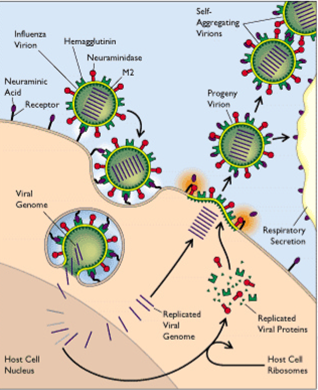
First, the virus attaches to a host cell (e.g., an epithelial cell lining the nasopharynx). The hemaglutinin protein (shown in green) on the exterior of the viral particle has a shape that enables it to bind to a neuraminic acid protein on the host cell. Binding triggers changes in the host cell membrane that cause it to invaginate and internalize the virus. The virus then sheds its protein coat, releasing its RNA into the cell. The viral RNA is used as messenger RNA to produce viral proteins. In this process the host cells ribosomes, amino acids, and ATP are used to create new viral proteins. One of the viral proteins that is replicated in a viral RNA polymerase that copies the viral RNA template to produce new copies of viral RNA for the replicated viral particles. Once there is a critical mass of new viral proteins and RNA, they self-assemble to form new viral particles that are released from the host cell either by budding off or by rupturing the cell membrane. These new viral particles can then infect additional host cells.
Still other RNA viruses, called retroviruses (e.g. HIV), use an enzyme called reverse transcriptase to copy the RNA genome into DNA. This DNA then integrates itself into the host cell genome. These viruses frequently exhibit long latent periods in which their genomes are faithfully copied and distributed to progeny cells each time the cell divides. The human immunodeficiency virus (HIV), which causes AIDS, is a familiar example of a retrovirus. The HIV life cycle is summarized in the illustration below.
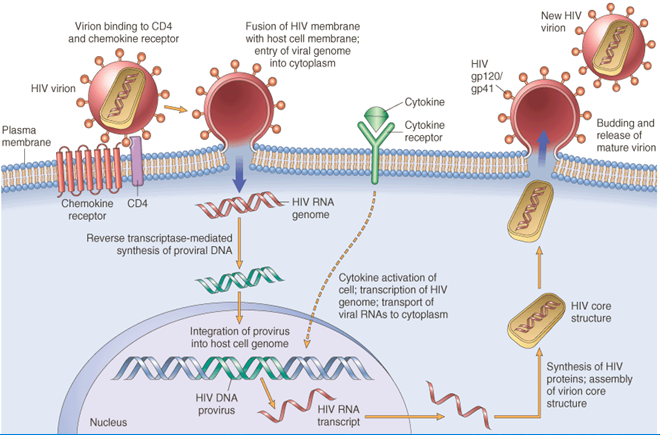
Source http://medicinembbs.blogspot.com/2011/02/diseases-of-immunity.html
This is a brief video that summarizes events that take place during HIV infection.
Patterns of Viral Infection
Viral infections can display several temporal patterns of disease. T
- Acute Viral Infections: The virus begins to replicate and kills cells. Over a course of days either the immune system defeats the infection and symptoms disappear or the host dies. Examples of these acute infections include the common cold, mumps, influenza, smallpox, and SARS. In the figure below the black line indicates changes in viral load over time, and the red shading indicates the occurrence of symptoms.

- Chronic Viral Infections: The viral load increase quickly after initial infection and remains sustained for a prolonged period, although the host is asymptomatic. Eventually, however, symptoms occur and become increasingly severe and result in death of the host. Examples: hepatitis B or hepatitis C.

- Latent Viral Infections: A good example is the varicella zoster virus. An initial infection with varicella causes chickenpox. The immune system responds and eliminates most viral particles, and symptoms of chickenpox subside. However, the virus remains dormant within certain cells, e.g., nerve cells, and it can periodically reactive in the distribution of nerves to episodes of localized rash, pain, and tenderness known as "shingles." Cold sores or "fever blisters" are due to latent infection with the herpes simplex virus.

- HIV Infection: After the initial infection the viral load increases and produces relatively mild symptoms, similar to the common cold. The immune system rapidly reduces the viral load, and symptoms abate, but HIV particles are still present in low levels in CD4 lymphocytes. The number of HIV particles waxes and wanes at a low level, slowly taking a toll on the immune system. If left untreated, the immune system eventually is weakened to the point where it is unable to cope with other infections, and the AIDS syndrome occurs. Opportunistic infections occur, and Kaposi's sarcomas (a cancer) occurs as a result of infection with another virus. Eventually the host dies.

Rogues Gallery of Viral Infectious Agents
|
|
|
|
|
|
|
|
|



